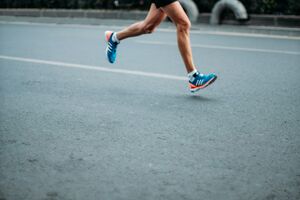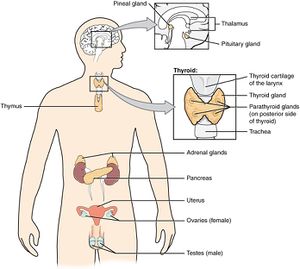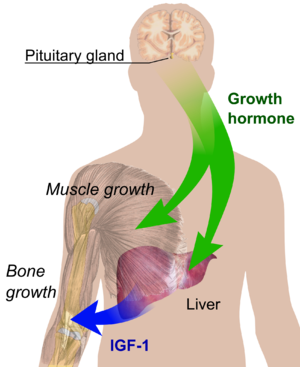Exercise Endocrine System Interaction
Original Editor - Lucinda hampton
Top Contributors - Lucinda hampton and Kim Jackson
Introduction[edit | edit source]
Physical exercise is a stressor to the human body and serves as a robust activator of the neuroendocrine system, provided that the exercise is of sufficient volume (i.e., intensity and/or duration). Accordingly the endocrine response to exercise can improve organ function, physical appearance and a persons state of mind. Vigorous exercise, in particular, improves endocrine function. The size of the neuroendocrine stress response to exercise seems directly proportional to the volume of exercise exposure.[1] Exercise brings about many beneficial hormonal changes, primarily being
- Plasma levels of cortisol, adrenalin, noradrenalin, and dopamine increase with maximal exercise and return to baseline after rest. The increase in levels is consistent with the increase in the sympathetic nervous system activation of the body.
- Growth hormone is released by the pituitary gland to enhance bone and tissue growth.
- Insulin sensitivity increases after long-term exercise.
- Testosterone levels also increase, leading to enhanced growth, libido, and mood[2].
The adaptability and plasticity in the neuroendocrine system to exercise training has a cut off point. Excessive exercise training can drive the neuroendocrine exercise stress response to become detrimental, possibly leading to the development of chronic fatigue and the overtraining syndrome condition[1].
Main Endocrine Effects[edit | edit source]
Throughout exercise several hormones (eg adrenaline, nor adrenaline, growth hormone and cortisol) are promoted and have an effect on our body.
These hormones include:
- Human Growth Hormone (HGH) is produced and secreted by the pituitary gland and promotes cellular growth. HGH is the primary hormone your body uses for growth and cell reproduction. Levels are highest during childhood, reaching a peak during puberty, and generally decline after middle age, During sleep, during the REM cycle HGH is produced. HGH is responsible for increasing muscle and bone growth and assists with controlling fat metabolism, fluids and sugars and supports our immune system. HGH is stimulated with high intensity strength or cardiorespiratory exercise.[3]However, there are natural ways to promote HGH production — like exercise. Exercise is among the most powerful stimulants for HGH production and can also promote better sleep, which is when your body releases the hormone most.
- Cortisol, a steroid hormone produced by the adrenal glands, helps with the management of blood sugar levels, metabolism, water and sodium balance, and blood pressure. When we experience stress, for example during exercise, cortisol is released, causing a fast breakdown of carbohydrates and fats, bringing about a rise in blood sugar for immediate energy. This is especially necessary during long durations of exercise. The Adrenal Gland, part of the endocrine system, releases cortisol into the bloodstream.
- Adrenaline helps to enhance cardiac function by increasing heart rate, constricting blood vessels and increasing blood pressure. This in turn helps to distribute blood flow to active tissues, providing these tissues with the energy and oxygen they need. Regular exercise training can improve your mood, with regular exercise causing a reduction in the levels of adrenaline at rest. Less sympathetic nervous system innervation leads to a reduction in the stressed feelings that adrenaline causes.[4]
- Dopamine, famed for causing the runners high. Studies show exercise increases dopamine levels in the brain, and subsequently decreases stress and depression. Increased dopamine also helps remove that uneasy feeling created by stress.[5]
- Serotonin. Exercise increases blood serum serotonin levels. An increase in serotonin levels can positively impact mood, social behavior, appetite, digestion, memory, sexual function and improve sleep[5].
- Glucagon and insulin, both secreted by the pancreas, act antagonistically to each other in order to maintain blood glucose levels. During exercise there is a greater demand from muscle tissue for blood glucose for fuel, bringing about a drop in blood glucose levels. Glucagon levels subsequently increase (with exercise) and insulin levels at the same time are suppressed. This ensures that blood glucose levels do not drop too low, as the brain can only use glucose to produce energy, and a lack of glucose could cause the brain tissue to die, a fatal consequence.[6]
- Testosterone, a steroid hormone produced by the testes in males and is found in small amounts in the ovaries of females, is responsible for muscle protein growth and repairs muscle damage which can occur during exercise. Males muscle mass, strength, sex drive, and sperm count are linked to his testosterone levels. As a man ages, testosterone naturally decreases. Testosterone is able to prevents muscle breakdown. Resistance and Hight Intensity Interval Training (HITT) exercises can cause beneficial increases to testosterone levels. [7]
- Estrogen. Menopausal symptoms are driven, in part, by the imbalance and decline of estrogen. Exercise is an effective conter to this. A heart rate increase for 30 minutes or more daily helps boost estrogen levels, which can help take lower the severity of menopause symptoms.[5]
Physiotherapy[edit | edit source]
As the experts in exercise prescription this page has highlighted another reason why we should encourage fitness and exercise. For examples:
- Regular physical activity stimulates hormones throughout the body, thus helping to maintain the body's sense of equilibrium and well-being. Along with all the other benefits of fitness, exercise has the ability to keep the body's hormones in balance, particularly insulin
- As you age there is a decrease in your functioning of the endocrine systwm. Regular exercise (5 days a week) can help keep this system working and slow the aging process.
References[edit | edit source]
- ↑ 1.0 1.1 Hackney AC. Stress and the neuroendocrine system: the role of exercise as a stressor and modifier of stress. Expert review of endocrinology & metabolism. 2006 Nov 1;1(6):783-92.Availsble:https://www.ncbi.nlm.nih.gov/pmc/articles/PMC2953272/ (accessed 10.8.2022)
- ↑ Patel PN, Zwibel H. Physiology, exercise. InStatPearls [Internet] 2021 Sep 18. StatPearls Publishing. Available: https://www.ncbi.nlm.nih.gov/books/NBK482280/(accessed 10.8.2022)
- ↑ Mather Hospital Exercise and hormones Available: https://www.matherhospital.org/weight-loss-matters/exercise-and-hormones/ (accessed 10.8.2022)
- ↑ Healthfully Does Exercise Cause an Adrenaline Rush? Available: https://healthfully.com/does-exercise-cause-an-adrenaline-rush-8235456.html (accessed 11.8.2022)
- ↑ 5.0 5.1 5.2 Peidmont How exercise helps balance hormones Available: https://www.piedmont.org/living-better/how-exercise-helps-balance-hormones (accessed 11.8.2022)
- ↑ PT direct The Endocrine System Available:https://www.ptdirect.com/training-design/anatomy-and-physiology/the-endocrine-system (accessed 10.8.2022)
- ↑ Shimojo G, Joseph B, Shah R, Consolim-Colombo FM, De Angelis K, Ulloa L. Exercise activates vagal induction of dopamine and attenuates systemic inflammation. Brain, behavior, and immunity. 2019 Jan 1;75:181-91. Available:https://pubmed.ncbi.nlm.nih.gov/30394312/ (accessed 10.8.2022)










